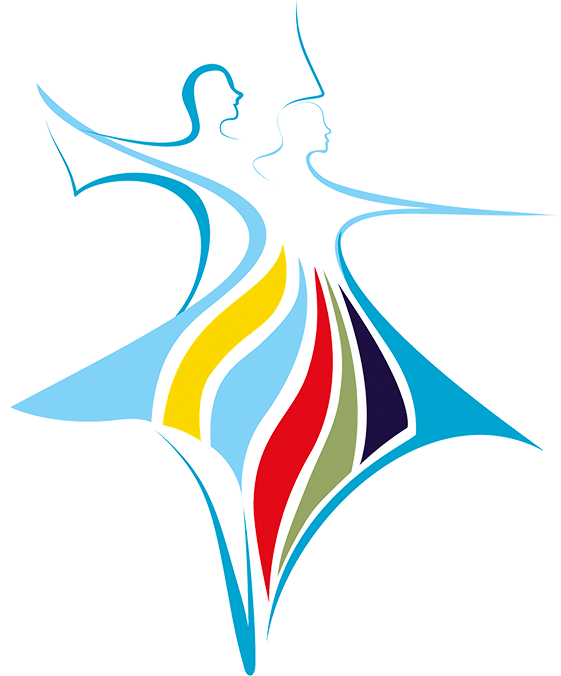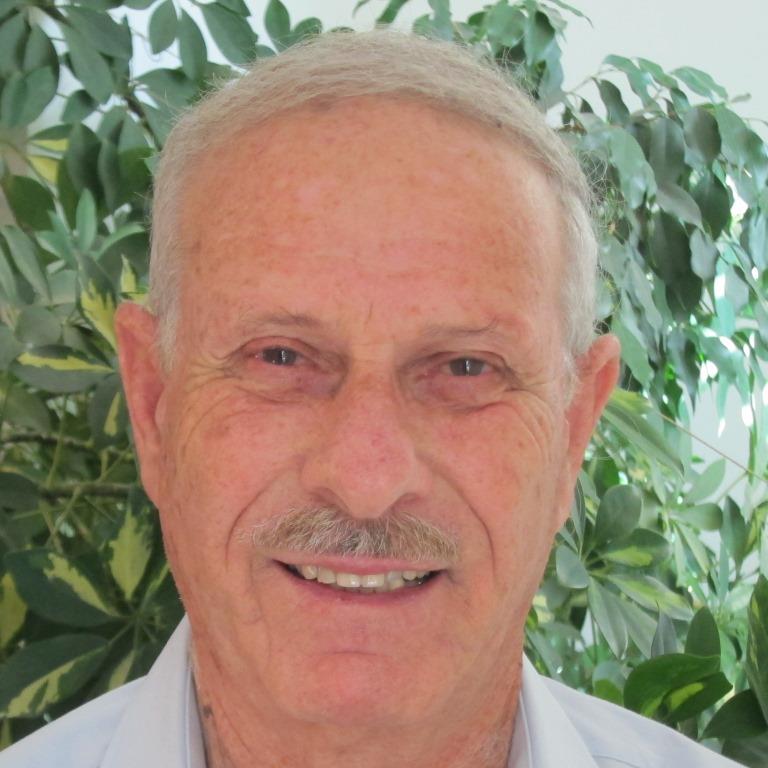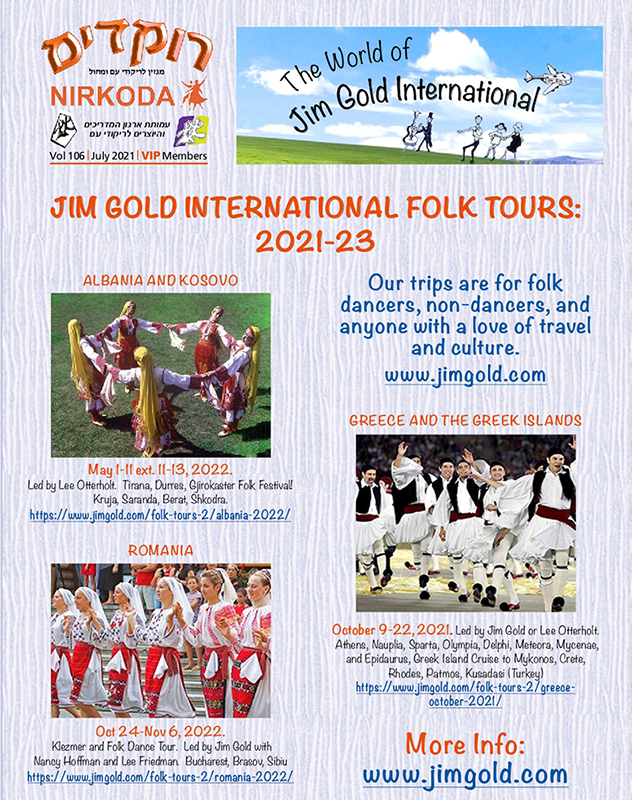- Home
- Rokdim Nirkoda 106
- To Plow a Fallow Field and Reap Folklore
To Plow a Fallow Field and Reap Folklore
The Creative Dance and Song Duo - Raya and Yossi Spivak
- Translation: Ruth Goodman
Perhaps no other creative duo has been as prolific as this special couple, Raya in dance and the late Yossi in music, who have enriched the State of Israel and world Jewry. The story of Raya and “Niguno Shel Yossi” (“Yossi’s Melody”), about decades of joint creative work, is in the article before us.
Raya says:
Every person has his/her own identity. Every nation also has its own identity that includes the songs, melodies, traditional attire, food, customs and even dances. The history of folk dance in the State of Israel recognizes prominent personalities and figures who, before and after the establishment of the State, have contributed and been influential. There were individuals whose work contributed to the construction of our Israeli folk dance component here (in Israel).
Among the leaders were couples whose joint work reflected the connection between the song, the text and especially the melody and dance. There was mutual fertilization between the composer and the creator of the dance. We met Leah Bergstein at Kibbutz Ramat Yohanan with the composer Matityahu Shelem. Tamar Alyagor and Gil Aldema at the Hadassim Youth Village, Rivka Shturman and Nira Chen in Kibbutz Ein Harod and others.
Later, the creative couple, Raya and Yossi Spivak were added to the list. Their uniqueness was that they were a married couple. They created and worked together – Yossi in music and Raya in dance. They worked a lot for the folk dance movement, its development and preservation. For 65 years, Raya and Yossi have been an integral part of the folklore of dance and music.
I am conducting this interview at the Spivak couple’s home in Holon. Raya‘s story is undoubtedly also related to Yossi, the musician who had been associated with the folk dance movement from its inception and for many years. Together they were a uniquely creative duo.
Raya tells us:
I was born in 1934. I spent my childhood, in the 1930s and 1940s, in the then North Tel Aviv. I studied at the grade school in the north and from there, I attended Ironi Dalet High School. At the age of 5, I had already started learning to dance with the great Gertrud Kraus and acted in the children’s theater of the Teachers’ Center. We performed at the Moghrabi Theatre.
The high school had a specialization in Israeli artistic expression and that’s how I met the drama teacher, Sara Levi-Tanai, and Tova Zimbel, the teacher of Israeli dance. The music instructor was Yossi Spivak. I danced in the high school performing troupe and that’s how I met Sara Levi-Tanai in the drama class.
Upon graduating from high school, I enlisted in the IDF and was integrated into various and special training positions; I completed my service as an outstanding student. When I finished my military service, I married Yossi, the music instructor from high school, and immediately after the marriage, I returned to study dance.
As a child, I studied classical dance and its foundations with Gertrud, but in my adulthood, I was introduced to modern dance that was, at the time, in its infancy. I was exposed to Martha Graham, who had come to Israel, and was one of the founders of the modern dance movement in the world; I was fascinated. After the marriage, I met Mrs. Hassia Levy-Agron, who founded the Dance Academy in Jerusalem. I studied for a few years with Hassia as part of the Conservatory’s group in Jerusalem. She is the one who helped me formulate a direction, clarified my understanding of dance and outlined my path as a teacher and creator.
How did you get into folk dancing?
While in school I had already met Gurit Kadman, who was the visionary of the idea and formulated our identity component through the folk dances of our country. As a child, I heard from her about the First Folk Dance Festival held at Dalia in 1944. I had already participated in the 1947 festival and had come with my parents. The festival continued throughout the night because a curfew had been imposed by the British through martial law.
What was first on your path to folk dance?
For me, my marriage to Yossi developed the direction towards folk dance. Yossi was already a well-known accordionist and accompanist; through him, I came to know Gurit well and later, other choreographers and dance personalities. They all worked with Yossi, who was considered to be a knowledgeable and prominent musician.
Gurit demanded from Yossi that I join in the work for the folk dance movement, which was in its infancy, and that I contribute my knowledge and skills. This is how she introduced me to Tirza Hodes, who ran the Histadrut’s folk dance section for 40 years. I was fascinated by Tirza‘s vigor and her instincts. Gurit told her that I have a dance education and that she should take advantage of it.
Later, at Gurit‘s suggestion, I created a dance that was supposed to be folk in nature and maintain an Israeli style. Gurit‘s idea was for Yossi to write a melody that would be in a kind of Yemenite-Israeli style. (It was the time of the aliyot to Israel.) The year was 1956. Yossi wrote the music and I immediately connected to the melody and created corresponding movements for it that made a statement. Sara Levi admired Yossi’s melody and Gurit loved the dance, but in her eyes, it lacked perfection because the melody had no lyrics. Yossi suggested that we look for a verse in the Bible. We turned to the comforting prophecy of the prophet Isaiah.
The verse was, “Ma Navu Al He’Harim Raglei Hamevaser – How Pleasant On The Mountains Are The Feet Of The Messenger” (Isaiah 52:7). The words matched that period of time, just as it does today. I wanted it to be a dance that meandered in a snake-like pattern in order to accommodate many dancers. It ended up as a circle dance. Gurit expressed her opinion and said, “This is a folk dance for the masses. It has both character and style”.
The song was liked by many singers and musicians and was widely recorded. From then on, all my works were always by request and/or invitation, as was “Niguno Shel Yossi”. This time, Gurit asked that it be in an Eastern European style, but Israeli. I wanted to create a circle dance but, to be more social, with couples in an alternating partner motif. I had the idea, then explained the structure I wanted to Yossi. Yossi did not even sit down next to the piano. He just took a piece of paper he found, made a “staff” (5 lines for musical notation), hummed and wrote a melody; and within 10 minutes, he said to me, “Take it!” On paper, Yossi had written down the notes and so we brought the melody and dance to the course for instructors.
Everyone was thrilled and Gurit was angry again: “There are no lyrics to the melody; it’s a waste of a beautiful dance!” We quickly called Yossi‘s faithful friend, the musician Aharon Shefi, who knew and knows how to rhyme quickly and so a song was born, but it still remained untitled. Aharon and I immediately said that this song should be called, “HaNigun Shel Yossi – Yossi’s Melody”. Of course, Yossi Spivak, and thus the composition was completed.
The melody caught on immediately; the dance [now known as “Niguno Shel Yossi”] found its place, but the lyrics were left behind despite their appropriateness to the time. Yehuda Emanuel redeemed the song and recorded it with the lyrics. Here they are:
“How happy is Saba’s (Grandpa’s) heart
With a glass of schnapps
How a handful of tobacco
Elevates the soul of every bloke
Ay, ay, ay, ay
Let’s raise a glass my friends
Another one – to life
And Am Yisrael Chai (the people of Israel live)”
I wanted the dance to express joy, openness, camaraderie and partnership through stylized simple steps based on walking, stamping, clapping hands and being folksy. Later, along the way, I created dances according to a special request or a specific need I faced for holidays, events, milestones, various situations and target populations. So it was with the dance, “Vaynikehu” [“Vaynikehu D’vash Misela – He Made Him To Suck Honey Out Of The Crag”, Deuteronomy 32:13], created at the request of Gil, who turned to Yossi to save the tune because all the singers were making mistakes with the meter. Gil wrote it in mixed meter and people who sang it added another quarter beat to the tune. Gil got angry and requested, “Raya, do something!”
I created a dance in mixed meter. This is a special example of adhering to the melody and not the other way around. In every dance I tried to keep the original melody, the original rhythm, the character and not vice versa. I always wanted the steps to be simple for the sake of the folk quality.
An important dance of mine is, “Noladeti LaShalom – I Was Born For Peace”, which was created at the onset of pop songs and was arranged especially for the recording. The musical accompaniment was stylized and with transitions. I decided to create a dance that would be Israeli-pop and exactly according to the melody, as written by Uzi Hitman, with the arrangement by Matti Caspi. The dance served as a backdrop for Anwar Sadat‘s arrival in Israel. The dance caught on and is danced by all: children, youth, adults and seniors.
Thus I created dances, out of thought and purpose, but I did not do much about it, as I turned to other channels of activity that would express our nation. It was important for me to develop our identity in dance folklore. For me, Tirza, Gurit and the wonderful framework of the Histadrut Cultural Center, were an inexhaustible fountain to promote and strengthen the importance of our special dance language, through proper expression, by understanding the roots that make up the people, the country and culture.
Towards this end, I mobilized my skills and my energy. For many years, I worked alongside Tirza instructing in the Ulpanim (training for dance instructors), with Yossi contributing in his role as a music teacher and composer. Yossi also wrote two books on the relationship between music and folk dance.
Before holidays, we organized seminars with Tirza to preserve the style and characteristics of each holiday. My crowning achievement was creating a Central Dance Folklore Workshop. The goal was to impart knowledge about dance folklore, in general, as well as our part in the development of Israeli folk dance.
Raya, tell us about the landmarks in your folk dance work.
During my work, I developed various fields and I also established myself as an organizer, presenter and director of folklore events; I gained a lot of support. I directed and staged a special evening of dance and song in memory of Emanuel Zamir [among the founders of informal singing ensembles and public sing-alongs], in collaboration with Ron Huldai, Mayor of Tel Aviv; a special evening for Gil Aldama upon his receiving the Israel Prize [for Hebrew Song]; an evening to mark the 40th anniversary of the folk dance section, and an evening about the Inbal Dance Theater and Gila Toledano.
And the national projects you initiated, Raya?
In 1963, 25 years after the establishment of the State of Israel, the Ministry of Education requested that ceremonies be held for this event in schools, which led me to understand the need for folk dance to be included in the education system. I worked on this subject for almost five years and built a curriculum called, “Beit Sefer Roked – Dancing School”. The conditions and possibilities seemed doable in order to institutionalize the subject area through physical education. I turned to the then Minister of Education, Zevulun Hammer, and I was privileged to receive backing and a budget from him. I went through all the districts in the country demonstrating school yard harkadot (group dancing) in every school. I published an instruction booklet for the 30th anniversary year of the State and during that year, I demonstrated a municipal ceremony with all the children of the city of Ashdod. The idea took hold throughout the country. Soon a generation of teachers arose who were enthusiastic about the idea and the annual conference of Beit Sefer Roked became a major event in many cities in the country.
During the Yom Kippur War, I was asked to contribute to special education children in dance and movement, which later led me to work for this population. I got involved in working at AKIM institutions [the national organization that cares for persons with intellectual and developmental disabilities in Israel] and services for the mentally challenged and special education. Thus, a powerful project was born that I am proud of. The project was recognized by a wonderful name, “Prachim u’Levavot – Flowers and Hearts“.
The students, like flowers, ask everyone to open their hearts. I created a work plan, I harnessed Yossi and we disseminated the plan all over the country. I moved from one care center to another and mentored instructors and trainees; I created a method of work and built representative groups in the various settings that could go out into the community with a properly staged show.
During 25 years, I established 21 dance groups from Tzfat to Dimona. Every year, we put on an impressive show and presented it at the Opera House – Performing Arts Center, in Tel Aviv. Later, I asked Yonatan Karmon [founder and] director of the Karmiel Dance Festival, for permission to bring Prachim u’Levavot groups to the festival where we also won special recognition and were integrated into Israeli folk dance.
The highlight of “Prachim u’Levavot” was participation abroad in an Arts Conference for the Exceptional. We won first place for the representation and performance. For me, it was a real lifetime achievement.
In the 1970s, I was invited to England to establish the idea of Beit Sefer Roked for the Jewish educational system there through a special organization that dealt with folk dance. The principals and teachers were very committed to the idea; I built activity programs for holidays and various study topics related to the people and the State of Israel, including the creation of instructional and musical materials.
The project manager in England, Maurice Stone, an avid folk dancer, thought that success in England could expand and contribute to post-Stalinist Jewry in the Soviet Union. With time, the news about my work reached the Jewish Agency in Jerusalem and the United Jewish Appeal. And so, Yossi and I were invited to the USSR. The year was 1989.
We were invited to teach and bring the great message of the State of Israel to the Jewry of the USSR through dance. Therefore, I prepared a special work program that would fit the goal of creating closeness, learning about Israel and would contribute toward immigration to Israel. I called the program “Jewishness and Israeliness in Dance, Movement and Song”. We brought along instructional booklets. Yossi took care of recorded music and, in our suitcases, we had hidden symbols of holidays and materials to deepen the learning. In each of the venues, a concluding event was held in an impressive and exciting way.
Something special about the history of folk dance?
In 1994 at Karmiel, on the 50th anniversary of Kibbutz Dalia, I directed and staged a salute to the first dance festival that was held in 1944. It was a huge show with three stages, the Karmiel choir and with the best dance troupes in the country that had recreated dances and performances by the creators of that time. Children, teenagers and adults took part in this show. They danced and evoked the memories of the first composers and choreographers through songs and melodies and folk music groups like in those times.
Yossi directed the musical side and I, the staging. It was a final show with the original Dalia veterans who came to speak and share with the best veteran dancers. It was a salute to history under the auspices of Adi Eldar – the then Mayor of Karmiel.
Where do you think Israeli folk dance stands today?
From the beginning of my involvement in activities and creating for Israeli dance and song, I have had ideas which have characterized our people, the country and our culture here. The values, the meaning, the integration of generations, the shared joy and the feeling of “togetherness” have guided me all the way. Unfortunately, over time, something became a bit damaged. We saved little and lost a lot. Today it’s not folklore; it’s more entertainment. An escape from the tradition of true popular expression. It’s not the values built by the founders; it’s something else.
In my time, if I was successful and contributed something from the belief in the identity of our folklore, and if through my activities I was able to put things into history, not only theoretical and nostalgic, but also into practical history, then I have achieved full satisfaction. And thank you to all the many I have known along the way.









Comments
התראות